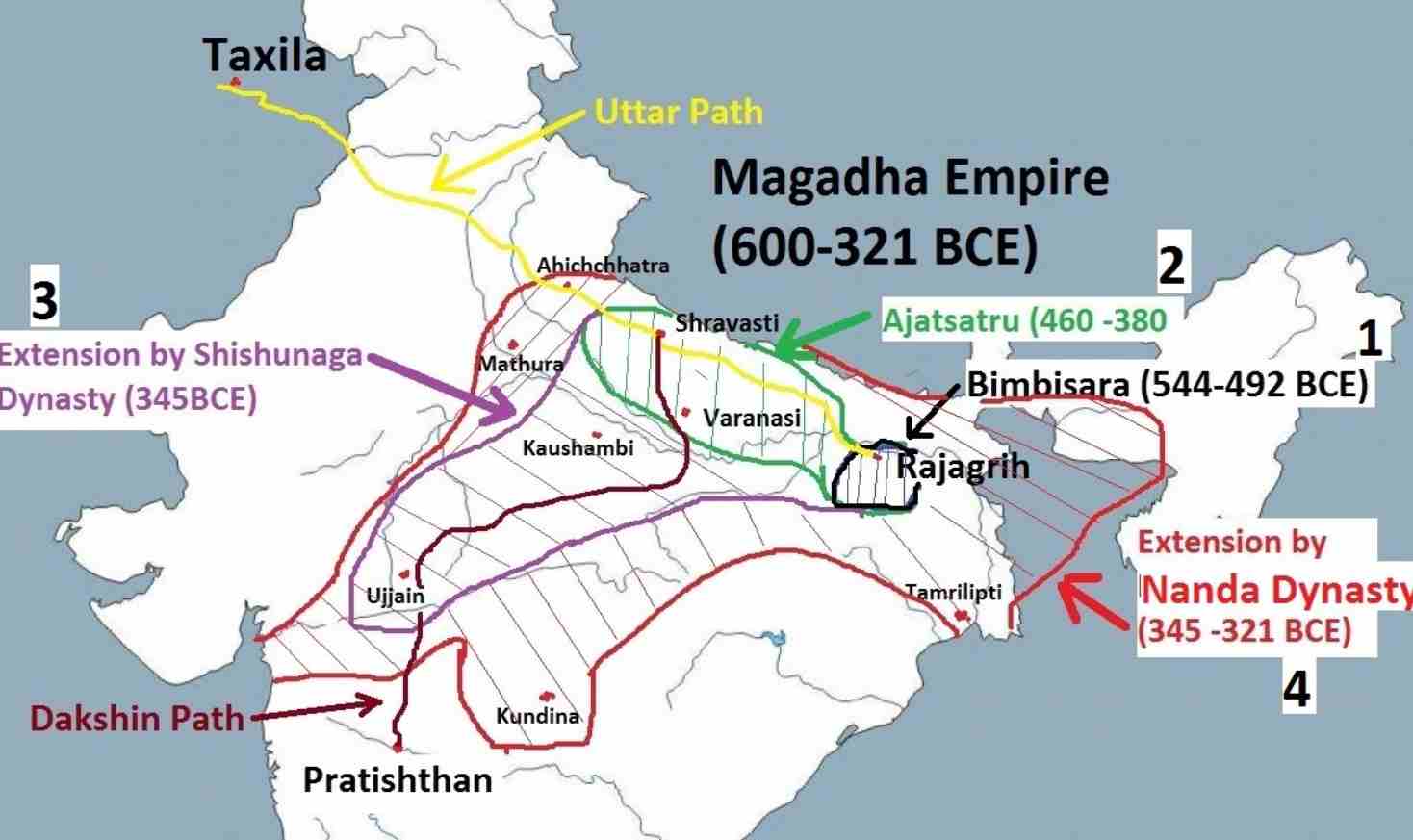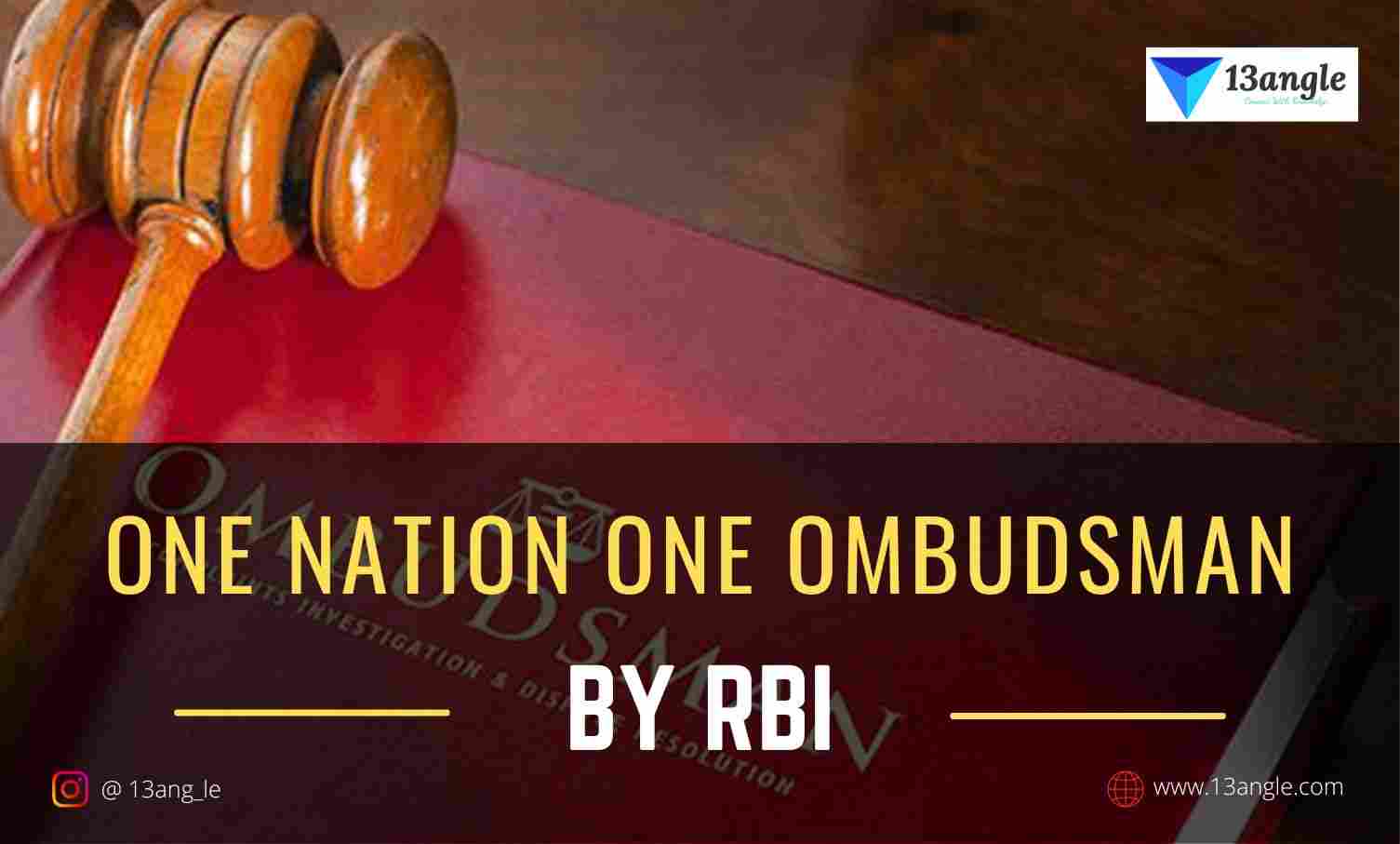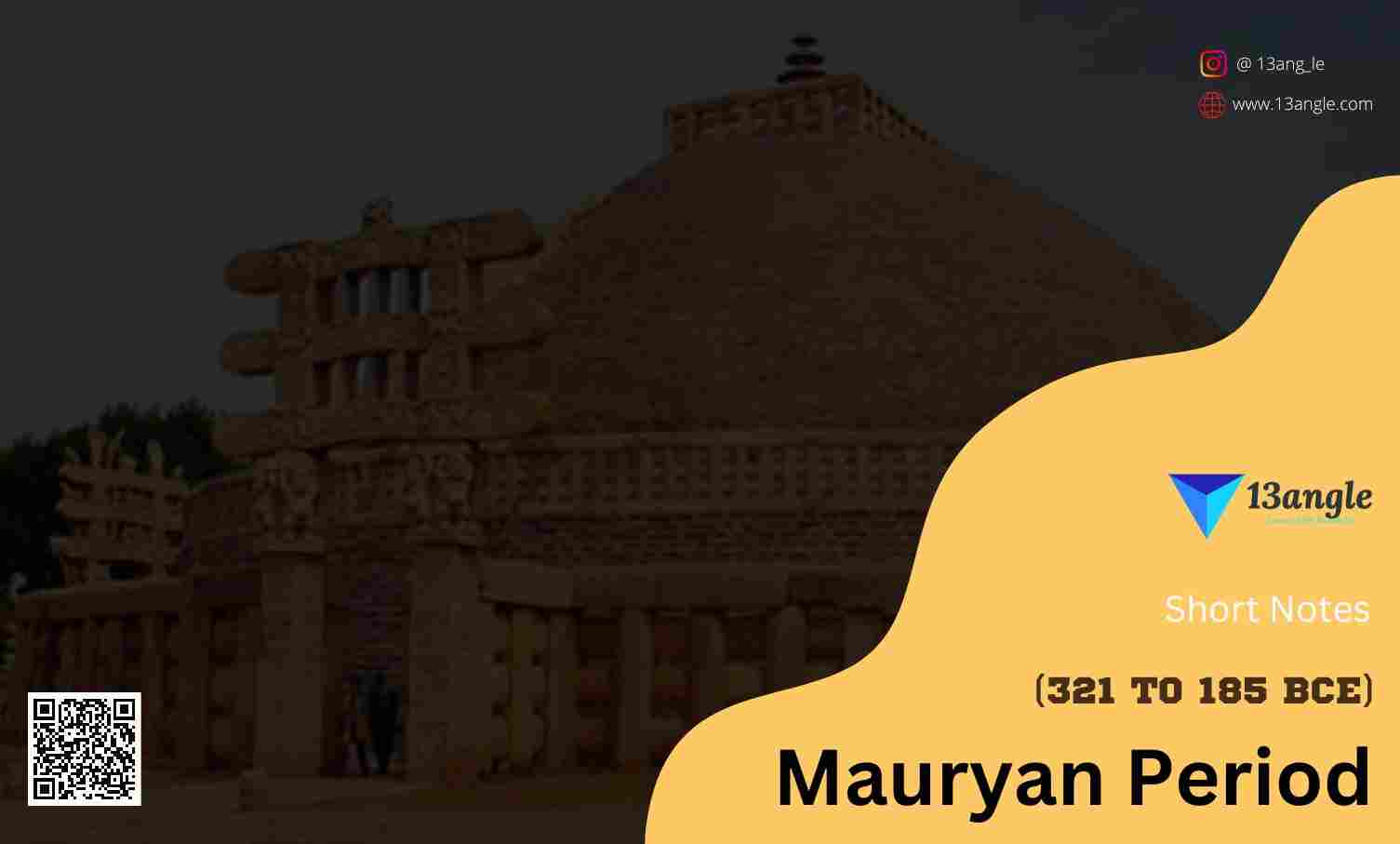
Brihadrath Dynasty
It was the first to rule over Magadha.
Brihadratha was the founder of the dynasty.
He founded Magadha on the banks of the Ganges and transferred power from Chedi (the kingdom next door) to the newly established Magadha.
He was the eldest son of Uparichara Vasu, Kuru king of Chedi.
He had a son named Jarasandha, who was very famous.
He had a daughter, Shashirekha, who was Dhrishtadhyumna’s second wife.
His name is also found in Rigveda.
Brihadrath’s son Jarasandha was the most well-known ruler. Jarasandha’s name appears several times in the Mahabharata and Puranas.
He was given many titles, including Mahabahu, Mahabali, and Devendra ke saman Tej wala Insaan. The capital of Jarasandh was Girivraja (Rajgir).
The Prodyota dynasty succeeded the Brihadrath dynasty in Magadha.
Magadha became the Central Power of India. Magadha was the most powerful Mahajanapada of India.
Pradyota Dynasty (682 BCE–544 BCE)
Pradyota is the dynasty’s founder and ruler of Avanti and Magadha.
The Pradyota dynasty was the Second dynasty that ruled Magadha.
The Pradyota dynasty belonged to the Abhira tribe.
Pradyota was the son of Pulika (Punika), who is said to have assassinated Brihadratha dynasty king Ripunjaya at Rajagriha to make his son king.
The 5 dynasty kings ruled for 138 years from 682 to 544 BCE.
Haryanka dynasty of Magadha succeeded the Pradyota dynasty.
Capital: Rajagriha.
Common languages: Sanskrit.
Religion: Hinduism
List Of Pradyota Dynasty Rulers
- Pradyota Mahasena: 682–659 BCE (For 23 Years)
- Palaka: 659–635 BCE (For 24 Years)
- Visakhayupa: 635–585 BCE (For 50 Years)
- Ajaka: 585–564 BCE (For 21 years)
- Varttivarddhana: 564–544 BCE (For 20 Years)
Haryanka Dynasty (544 B.C. To 492 B.C.)
The third dynasty to rule Magadha was the Haryanka Dynasty.
Bimbisara is regarded as the dynasty’s primary founder.
Rajagriha was the initial capital.
During Udayin’s reign, it was later relocated to Pataliputra, near present-day Patna in India.
Bimbisara was made king at the age of fifteen by his father, Bhattiya (According to the Buddhist text known as the Mahavamsa).
Magadha rose to become the dominant force in the 6th century B.C., with an estimated 80,000 villages.
Shishunaga dynasty of Magadha succeeded the Harankya dynasty.
Haryanka dynasty was ultimately overthrown out of power by their Amatya (minister), Shishunaga.
Capital- Rajagriha later Pataliputra.
Common languages-Sanskrit, Magadhi Prakrit & Other Prakrits.
Religion- Jainism, Hinduism & Buddhism.
List Of Haryanka Dynasty Rulers
- Bimbisara (544–492 BCE)
- Ajatashatru (492–460 BCE)
- Udayin (460–444 BCE)
- Anuruddha (444–440 BCE)
- Ngadsaka Munda (440–437 BCE)
- Nagadarshaka (437–413 BCE)
1. Bimbisara:-
He founded the dynasty.
He was made king at the age of fifteen by his father, Bhattiya.
He lived during Buddha’s lifetime.
He made Rajgriha his capital.
He expanded his empire through matrimonial alliances, such as Kosala.
He was also the first ruler in history to establish a permanent army.
He was the first monarch to use elephants in battle.
He was given the title Seniya.
He also dispatched royal physician Jivaka to Ujjain to treat Chanda Pradyota, King of Avanti and his longtime rival who later became a friend.
According to the Uttaradhyayana Sutra, he was a Mahavira follower, whereas the Sutta Nipata depicts him and his wife, Khema, as Buddha followers.
2. Ajatshatru:-
He assassinated his father Bimbisara to become the next ruler.
He married Kosala’s princess Vajira.
He lived around the same time as Mahavira (599-527 BCE) and Gautama Buddha (563–483 BCE).
During his reign, Lord Buddha attained Mahaparinirvana and Lord Mahavira attained Moksha.
The first Buddhist Council (483 B.C.) was held at Rajgir under his patronage.
He conquered the Vajjika League, which was ruled by the Lichhavis.
During the reign of Ajatashatru, the first Buddhist council was held in Rajgir’s Saptaparni cave on Vaimar hill.
At first, Ajatshatru fortified Rajgir and erected a powerful fort at Patilgram.
He also created the Shilakanthak and Rathmusala battle weapons.
3. Udayin:-
To take over as the new ruler, he also killed his father, Ajatshatru.
He established Patliputra as his capital at the confluence of the Ganga and Sone rivers.
Udayin is also known as Udayabhadra.
Udayin is mentioned as Ajatashatru’s successor in Buddhist and Jain texts. Puranas, on the other hand, identify him as the fourth king after Darshaka.
Udayin was murdered by a spy appointed by Avanti Naresh Palak.
Udayin was a follower of Jainism.
Last Rulers
According to the Puranas, Udayin’s successors were Nandivardhana and Mahanandin.
Anurudhha, Munda, and Nagadarshaka were udayin’s successors, according to Buddhist tradition.
Nag Dashak served as the last king of the Haryanka dynasty. The Puranas also refer to him as Darshak. He was killed by Shishunag.
Shishunaga Dynasty 412 B.C. to 344 B.C)
Sishunaga was the fourth dynasty to rule the ancient Indian country of Magadha.
According to the Hindu Puranas, this dynasty succeeded Nagadashaka of the Haryanka dynasty as the second governing dynasty of Magadha.
The Shishunaga dynasty succeeded Udayin, and the capital was briefly moved to Vaishali during its brief rule.
They ended the struggle between Magadha and Avanti by crushing Avanti’s power.
A Sisunaga emperor named Kalasoka (Kakavarin) relocated the capital from Vaishali to Pataliputra. Kalashoka was succeeded by his 10 sons.
The Nandas eventually displaced the Sisunagas.
Common languages- Sanskrit, Magadhi Prakrit & Other Prakrits.
1. Shishunaga:-
Shishunaga established his kingdom in 413 BCE in Rajgir, which later became Pataliputra.
He served as viceroy of Banaras.
According to Buddhist traditions, he maintained a second capital there at Vaishali, which was home to Vajji until Magadha overran it.
One of the biggest empires on the Indian subcontinent was ruled by the Shaishunaga dynasty.
The destruction of the Pradyota dynasty of Avanti was Shisunaga’s most significant accomplishment. The conflict between Magadh and Avanti, which had lasted 100 years, was finally resolved as a result. Avanti then merged with Magadh.
2. Kalashoka:-
Shishunaga was succeeded by his son Kakavarna in the Puranas and by his son Kalashoka in the Sinhala chronicles.
He relocated his capital to Patliputra, which became the capital of the Magadha Empire.
The second Buddhist Council (383 B.C.) was held at Vaishali under his sponsorship.
He served as Varanasi’s governor under Shishunaga’s rule.
According to the Harshacharita, he was slain by a dagger inserted into his throat near his capital. He had nine or ten sons, according to Buddhist tradition, who were exiled by Ugrasena Nanda.
Later Kings
According to Buddhist tradition, Kalashoka’s ten sons ruled at the same time.
Bhadrasena, Korandavarna, Mangura, Sarvanjaha, Jalika, Ubhaka, Sanjaya, Koravya, Nandivardhana, and Panchamaka are listed as their names in the Mahabodhivamsa.
Only Nandivardhana is listed in the Puranic lists.
The ninth Shaishunaga monarch, according to the Puranas, was Nandivardhana, while the tenth and final Shaishunaga king was his son Mahanandin. His illegitimate son from a Shudra wife, Mahapadma, assassinated Mahanandin.
Nanda Dynasty
It was founded by Mahapadma Nanda, the son of a low-caste lady.
The last Nanda emperor was Dhanananda.
Nanda kings possessed the capable administrative framework required to manage a sizable realm.
Ancient sources claim that they earned enormous fortunes because of implementing a new currency and taxation system.
Ancient sources state that the Nandas were hated by their citizens because of their low social standing, heavy taxation, and general bad behaviour.
Taxes were prioritized and collected properly, and the administrative framework was well-organized. Because their methods were so effective, they were adopted even throughout the reign of the Maurya dynasty.
The king of the Nanda dynasty allegedly possessed a four-fold army made up of 20,000 cavalry, 2,000 chariots, and 3,000 war elephants, with 2 lakh infantries as the backbone.
Capital: Patliputra.
Religion: Buddhism, Jainism, and Hinduism were all practiced by people living in the Nanda Empire.
Today part of Bangladesh, India & Nepal.
According to the Sri Lankan Buddhist text Mahavamsa, written in Pali, there were 9 Nanda monarchs – they were brothers who ruled in succession for a total of 22 years. These were the nine kings:
Ugra-sena (Uggasena in Pali), Panduka, Pandugati, Bhuta-pala, Rashtra-pala, Govishanaka, Dasha-siddhaka, Kaivarta and Dhana.
1. Mahapadma Nanda:-
Mahapadma Nanda overthrew the Shishunaga dynasty in Magadha and founded the Nanda dynasty.
It lasted from 345 BC until 321 BC.
He received the honorary titles Sarvakshatrantaka and Ugrasena.
He is known as the first historical emperor of India in several places.
In the Puranas, Mahapadma Nanda is known by two names: Ekarat and Sarva Kashtriyantaka.
He assassinated Kalasoka to become king.
It is believed that Mahapadma Nanda, the dynastic leader who established the Nanda administration, was of a low caste.
He was the Kshatriya emperor Mahanandin’s son from the Shishunaga dynasty. His mother was from the Shudra group.
According to various Jain scriptures and the Greek historian Curtius, he was the son of a barber and a prostitute.
During his rule, the empire expanded. It extended south from the Kuru country to the Godavari Valley and east from Magadha to the Narmada.
He also built irrigation ditches in Kalinga.
2. Dhana Nanda:-
He was the last Emperor of Nanda.
In Greek, he is known as Agrammes or Xandrames.
During his reign, Alexander attempted to invade North-Western India but was thwarted by his army’s resistance, preventing him from reaching the Gangetic plains.
Dhana Nanda received his father’s vast wealth as an inheritance. He had 20,000 cavalries, 3000 elephants, 2000 chariots, and 200,000 men ready to go. He grew to be a strong ruler as a result.
He is credited for creating Nandos Pakraman (a specific measure).
He lost the support of his populace due to his strict taxing tactics.
He also had a lot of opponents because of his Sudra heritage and anti-Kshatriya stance.
He was deposed by Chanakya and Chandragupta Maurya, who used the uproar among the populace to establish the Maurya Empire in Magadha.
Nanda Dynasty – Administration
The Nanda king is referred to as ekarat (“one ruler”) in the Puranas, which shows that the Nanda empire was an integrated monarchy rather than a collection of largely separate feudal republics. However, the Greek narratives indicate the presence of a more federated structure of governance.
According to historian H. C. Ray chaudhuri’s theories, the Nandas granted significant autonomy in the frontier regions of their empire while maintaining centralized control over their core holdings in modern-day Bihar and Uttar Pradesh.
According to Buddhist tales, Chandragupta was unsuccessful in defeating the Nandas when he assaulted their city but succeeded in doing so when he gradually took control of their frontier areas.
Factors Influencing The Nanda Dynasty's Prominence
Geographical Aspects
Magadha was situated on the upper and lower portions of the Gangetic valley and was on the main land route connecting the west and east India.
The region had a lot of fertile lands. It also received an adequate amount of rain.
Magadha received its name from the Ganga, Son, and Champa rivers (also known as Chandan rivers) that surrounded it on three sides.
The dynasty was untouchable because of the vast army’s ability to fend off enemy attacks.
- Rajgir and Pataliputra were both crucial from a strategic perspective.
Economic Aspects
Magadha had abundant copper and iron riches, and its advantageous location let it easily control trade.
It possessed a sizable population that could be used for mining, the development of cities, agriculture, and warfare.
Due to prosperity, the general welfare of the populace and the rulers was guaranteed.
Control over the Ganga was equated with economic dominance.
- The Ganga in North India was essential for trade.
Political Aspects:
Political variables
Magadha was blessed with a slew of powerful and ambitious rulers, all of whom commanded enormous standing armies.
They were able to create better weapons because iron was easily accessible.
They were also the first rulers to use elephants in combat.
- A well-organized administrative system was also built by the main monarchs.
Cultural Aspects
The culture of Magadha was unique.
It contained a decent mixture of both Aryans and non-Aryans.
The rise of Jainism and Buddhism brought about a philosophical and intellectual revolution.
They made liberal traditions more robust.
- Many of Magadha’s monarchs came from “low” origins, and Brahmanas did not rule society.
Decline Of The Nanda Dynasty
Every historical account state that the last Nanda king was hated by his people.
In Sri Lankan Buddhist history, the Nandas are accused of being self-centered and enforcing onerous levies.
The Indian Puranas refer to the Nandas as adharmika, implying that they did not uphold dharma, or morality.
The Nanda dynasty was overthrown by Chandragupta Maurya with the aid of his guru and later minister Chanakya.
The Buddhist text Milinda Panha mentions a battle between Chandragupta and the Nanda general Bhaddasala.
In this battle, 10,000 elephants, 100,000 horses, 5,000 charioteers, and a billion-foot soldiers perished, according to the book.





